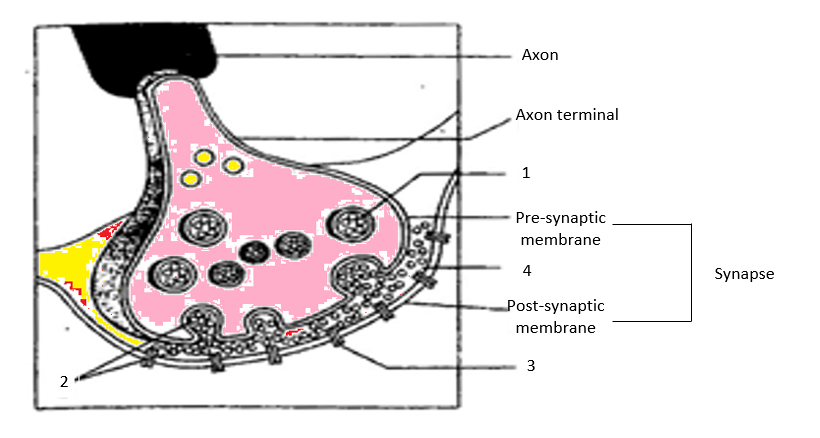
In the given figure of synapse few structures are marked as 1, 2, 3, and 4. Study the figure carefully and identify the structure which transmits a signal across a chemical synapse.

A. 1
B. 2
C. 3
D. 4

Answer
263.1k+ views
Hint:
Synapses refer to the points of contact among neurons in which information is passed from a single neuron to the next. Synapses most frequently form among axons and dendrites and are composed of a synaptic cleft, a presynaptic neuron, and a postsynaptic neuron.
Complete answer:
Synapse is the gap between the nerve ending of a single neuron and the dendrites of another. At the synapse, the electrical impulse produced at the dendrites of a neuron is transferred to the dendrite of another neuron in the type of chemicals by one end of the first neuron. Synapse makes sure that nerve impulse travels only in a single direction. A similar synapse enables the delivery of impulses from the neuron to other cells, such as muscle cells. At chemical synapses, the electrical signal within neurons referred to as an action potential is translated into a chemical signal that can travel through the synapse to the next neuron in the circuit. Rimer stated, “Synapses can be believed of as a relay post among the cells, in which one should convert a signal”. This is done through the discharge of chemicals known as a neurotransmitter, which are released in packets known as vesicles upon arrival of an action potential at the synapse. Once the neurotransmitter reaches the following neuron in the chain, the chemical signal is transformed back into an action potential that travels along that neuron to the subsequent synapse, and so on. When an impulse or nerve signal reaches the axon’s end, the vesicle releases a neurotransmitter into the small gap between adjacent cells (synaptic gap). Neurotransmitters diffuse throughout the synapse and bind to receptors in the receiving cell that is specific for the neurotransmitter.
Option ‘B’ is correct
Note:
Synapses are portions of the circuit linking sensory organs, like those that recognize touch or pain, in the peripheral nervous system to the brain. Synapses link the neurons in the brain to neurons throughout the rest of the body and from those neurons to the muscles. This is how the intention to move our arm, for example, translates into the muscles of the arm moving. Synapses are also essential within the brain and play an important role in process of memory formation.
Synapses refer to the points of contact among neurons in which information is passed from a single neuron to the next. Synapses most frequently form among axons and dendrites and are composed of a synaptic cleft, a presynaptic neuron, and a postsynaptic neuron.
Complete answer:
Synapse is the gap between the nerve ending of a single neuron and the dendrites of another. At the synapse, the electrical impulse produced at the dendrites of a neuron is transferred to the dendrite of another neuron in the type of chemicals by one end of the first neuron. Synapse makes sure that nerve impulse travels only in a single direction. A similar synapse enables the delivery of impulses from the neuron to other cells, such as muscle cells. At chemical synapses, the electrical signal within neurons referred to as an action potential is translated into a chemical signal that can travel through the synapse to the next neuron in the circuit. Rimer stated, “Synapses can be believed of as a relay post among the cells, in which one should convert a signal”. This is done through the discharge of chemicals known as a neurotransmitter, which are released in packets known as vesicles upon arrival of an action potential at the synapse. Once the neurotransmitter reaches the following neuron in the chain, the chemical signal is transformed back into an action potential that travels along that neuron to the subsequent synapse, and so on. When an impulse or nerve signal reaches the axon’s end, the vesicle releases a neurotransmitter into the small gap between adjacent cells (synaptic gap). Neurotransmitters diffuse throughout the synapse and bind to receptors in the receiving cell that is specific for the neurotransmitter.
Option ‘B’ is correct
Note:
Synapses are portions of the circuit linking sensory organs, like those that recognize touch or pain, in the peripheral nervous system to the brain. Synapses link the neurons in the brain to neurons throughout the rest of the body and from those neurons to the muscles. This is how the intention to move our arm, for example, translates into the muscles of the arm moving. Synapses are also essential within the brain and play an important role in process of memory formation.
Recently Updated Pages
Express the following as a fraction and simplify a class 7 maths CBSE

The length and width of a rectangle are in ratio of class 7 maths CBSE

The ratio of the income to the expenditure of a family class 7 maths CBSE

How do you write 025 million in scientific notatio class 7 maths CBSE

How do you convert 295 meters per second to kilometers class 7 maths CBSE

Write the following in Roman numerals 25819 class 7 maths CBSE

Trending doubts
Fill the blanks with the suitable prepositions 1 The class 9 english CBSE

State and prove Bernoullis theorem class 11 physics CBSE

Full Form of IASDMIPSIFSIRSPOLICE class 7 social science CBSE

What are Quantum numbers Explain the quantum number class 11 chemistry CBSE

Difference Between Plant Cell and Animal Cell

Given that HCF 306 657 9 find the LCM 306 657 class 9 maths CBSE




